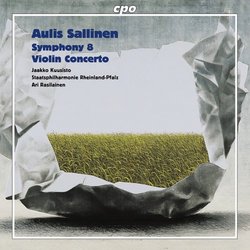| All Artists: Aulis Sallinen, Ari Rasilainen, Rheinland-Pfalz Staatsphilharmonie Title: Aulis Sallinen: Symphony No. 8; Violin Concerto Members Wishing: 1 Total Copies: 0 Label: Cpo Records Release Date: 5/17/2005 Genres: Jazz, Special Interest, Classical Styles: Swing Jazz, Marches, Forms & Genres, Concertos, Instruments, Strings, Symphonies Number of Discs: 1 SwapaCD Credits: 1 UPC: 761203997220 |
Search - Aulis Sallinen, Ari Rasilainen, Rheinland-Pfalz Staatsphilharmonie :: Aulis Sallinen: Symphony No. 8; Violin Concerto
 | Aulis Sallinen, Ari Rasilainen, Rheinland-Pfalz Staatsphilharmonie Aulis Sallinen: Symphony No. 8; Violin Concerto Genres: Jazz, Special Interest, Classical |
Larger Image |
CD Details |
CD ReviewsImmensely Likable and Important Music J Scott Morrison | Middlebury VT, USA | 05/29/2005 (5 out of 5 stars) "One of the wonders of our modern age has been the outpouring of extraordinary music from a group of Finnish composers including, as here, the attractive, accessible, masterfully constructed and lasting music of the immensely talented Aulis Sallinen (b. 1935). He has been responsible for furthering the cause of Finnish opera, with such works as (giving their English titles) 'The King Goes Forth to France,' 'The Red Line,' 'The Horseman,' 'Kullervo,' 'The Palace' and, most recently, 'King Lear.' All of these operas have been produced widely. And most have inspired non-operatic works by Sallinen, making use of themes, ideas, gestures contained in the operas. In this issue, containing four works, those echoes of operatic works are in evidence.
The first work here, and one of my favorite short modern orchestral works, is 'Shadows,' an nine-minute masterpiece (with reminiscences of 'The King Goes Forth to France') that contains most of the fingerprints of Sallinen's mature style -- masterful orchestration (with particularly inventive use of tuned percussion), Sibelian mosaic style, echoes of pop dance music, dream-like nostalgic recollections of music of the past, catchy rhythms, sassy wit and emotional depth. 'Shadows' has been recorded before by Okku Kamu and the Helsinki Philharmonic on Finlandia. This performance differs from that one in that it is somewhat smoother and richer, but each performance has its felicities; I really like the snappy little wind interjections in the Kamu version, but I prefer the cumulative emotional effect of the present recording. This is a work that every collection should contain, if only to prove to any doubters that there are masterpieces, both immediately likable and rewarding for long-term close study, being written in our era. This is followed by Sallinen's latest symphony, No. 8, subtitled 'Autumn Fragments,' from 2001. This is its first recording. Twenty-five minutes long and in one movement, it is immediately recognizable as first-rate Sallinen. Written during 2001 but finished immediately after the events of September 11, 2001, the composer says that the ending was altered by that tragic set of events and indeed, as Martin Anderson says in his valuable booklet notes, the ending brings 'neither resolution nor peace.' This is a deeply moving work in which Sallinen quotes the 'Theme of the Dead' from his opera 'Kullervo.' Commissioned by the Royal Concertgebouw, it also has a theme that uses the musical tones from the words 'ConCErtGEBouw AmstErDAm.' There is a particularly striking five-part canon, toward the end, on the Kullervo theme. The oldest piece here, the Violin Concerto, Op. 18 from 1968 is in Sallinen's then newly-emerged tonal style -- he had early in his career, like so many composers of his generation, composed in a rather more modernist style -- and was written for violinist Oleg Kagan. But Kagan was not allowed to exit the Soviet Union for the concerto's première and that responsibility then fell to violinist Okku Kamu who shortly after exchanged his bow for a conductor's baton and has remained a champion of Sallinen's work. To quote Anderson again, in the concerto Sallinen 'found a voice that is unmistakably his: the use of repeated motifs, juxtaposition of contrasted material, snippets of dance music' and a characteristic harmonic language. The Concerto, eighteen minutes long and in three movements, is played convincingly by rising Finnish violinist Jaakko Kuusisto. Again, there are unusual effects, particularly in the use of bell tones in the tuned percussion. In the opening of the middle movement the vibraphonist is instructed to play his pianissimo opening passage with his fingertips and both the orchestral pianist and harpist are asked to use a plectrum to pluck their strings. The final piece, 'The Palace Rhapsody,' was written a year after the première of the opera, 'The Palace,' and uses some of its elements. It is for wind ensemble and is notable not only for its symphonic use of the wind band's limited palette, but for both its wit and, in spots, its menace. ('The Palace' is a trenchant satire that wittily punctures the pretensions of those in power but without downplaying their menace.) One could not ask for better performances -- although one can hope that there will be additional performances and recordings of all these wonderful pieces -- by Ari Rasilainen (who, like Kamu, is a fervent champion of Sallinen's music) and the impressive Staatsphilharmonie Rheinland-Pfalz, who are giving us a series of really valuable recordings of neglected modern music on the cpo label. Heartily recommended and particularly so for those who are not, up to now, familiar with Sallinen's exceedingly attractive music; this would be a good place for them to start, and one would hazard a guess that a new listener, having heard it, would be converted to a Sallinen fan. TT=67'50 Scott Morrison" |
